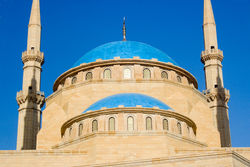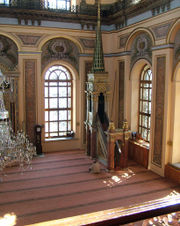 Architecture - Domes
Architecture - Domes
According to the book "Persian architecture; the triumph of form and color" by Arthur Upham Pope, two important contributions to architecture by the pre-Islamic Parthian and Sassanian Persians were domes and arches. Domes have long been a hallmark of mosques and Islamic architecture in general since the seventh century.

Moreover, it was in this century that Islam was introduced to Persia. The domes, which often are placed directly above the main prayer hall, may signify the vaults of heaven and the sky.

As time progressed, the sizes of mosque domes grew, from occupying only a small part of the roof near the mihrab to encompassing all of the roof above the prayer hall. Although domes normally took on the shape of a hemisphere, the Mughals in India popularized onion-shaped domes in South Asia and Persia. Some mosques will have multiple, often smaller, domes in addition to the main large dome that resides at the center.

(click to enlarge - The domes of the Khatem Al Anbiyaa Mosque in Beirut, Lebanon )

The prayer hall, also known as the musalla, has no furniture; chairs and pews are absent from the prayer hall so as to allow as many worshippers as possible to line the room.

Prayer halls contain no images of people, animals, and spiritual figures as Muslims in prayer are supposed to only be focusing on Allah. Instead, mosques will have Arabic calligraphy and verses from the Qur'an on the walls to assist worshippers in focusing on the beauty of Islam and its holiest book, the Qur'an, as well as for decoration.

(click to enlarge - The prayer hall, or musalla, in a Turkish mosque, with a minbar )

Usually opposite the entrance to the prayer hall is the qibla wall, which is the visually emphasized area inside the prayer hall. The qibla wall should, in a properly oriented mosque, be set perpendicular to a line leading to Mecca, the location of the Ka'bah.

Congregants pray in rows parallel to the qibla wall and thus arrange themselves so they face Mecca. In the qibla wall, usually at its center, is the mihrab, a niche or depression indicating the qibla wall. Usually the mihrab is not occupied by furniture either. Sometimes, especially during Friday prayers, a raised minbar or pulpit is located to the side of the mihrab for a khatib or some other speaker to offer a sermon (khutbah). The mihrab serves as the location where the imam leads the five daily prayers on a regular basis.
Ablution facilities

As ritual purification precedes all prayers, mosques often have ablution fountains or other facilities for washing in their entryways or courtyards. However, worshippers at much smaller mosques often have to use restrooms to perform their ablutions. In traditional mosques, this function is often elaborated into a freestanding building in the center of a courtyard.

This desire for cleanliness extends to the prayer halls where shoes are disallowed to be worn anywhere other than the cloakroom. Thus, foyers with shelves to put shoes and racks to hold coats are commonplace among mosques.
Contemporary features

Modern mosques have a variety of amenities available to their congregants. As mosques are supposed to appeal to the community, they may also have additional facilities, from health clinics to libraries to gymnasiums, to serve the community.